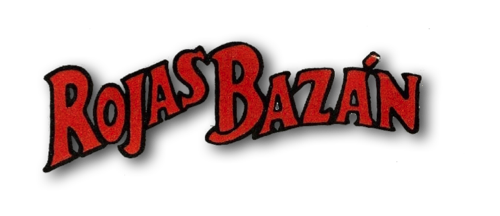TRANSLATION OF PEGASO AEROMODELISMO - 2011
Translation of page 1:
Interview with model craftsman
Mr. Guillermo Rojas Bazán
I had the honor and pleasure of contacting Mr. Rojas Bazán. Our friendship is virtual (since we don't know each other personally).
As often happens, this relationship arose by chance. Simply a few years ago, while buying some accessories in a hardware store, I came across a brochure from our well-known "Poxipol", where they had made a brief note; I was impressed by his work and kept the pamphlet simply for anecdotal reference.
A month ago, while arranging things in my house, I found the brochure again, I decided to visit Rojas Bazán's personal site and I was truly amazed by his work. I got excited and sent him an email with the simple purpose of congratulating him, and I really didn't expect more than that (it usually happens and it is common for no one to respond, it is known that there are a lot of spam emails that one receives).
However, for some reason Mr. Bazán responded to me, and the most curious thing is that we ended up writing to each other quite a bit. Apart from modeling we have found some things and people in common, and to make a long story short, I decided to ask him for a interview to spread his work to all the friends of "Pegaso". I appreciate his kindness since he accepted without hesitation.
Presentation:
This presentation is only a small summary, since his resume is very extensive and you can see it in full on his site.
Mr. Guillermo Rojas Bazán is of Argentine nationality, he is currently living in the United States and is the second generation of a family of model makers.
Guillermo's father was the one who began making static models as a hobby. Guillermo Jr. followed the same steps with plastic modeling in 1/72 scale, also experimenting with other scales, and like his father, he later moved on to the so-called "scratch" models (term used to define the construction of models at scales that don't exist on the market).
He began using wood as a raw material and then dedicated himself fully to aluminum sheets. His extensive resume as an international builder in both Europe and North America shows his vast experience. I recommend you visit his site, his models really are a work of art.
The site address is http://rojasbazan.com/
Interview:
MP: How is your family made up?
GRB: There are three of us, my wife Clarisa, my son Roy and me.
MP: What were you doing before dedicating yourself to models?
GRB: I was a musician, cartoonist and bank employee.
MP: Who or what was your reference when starting the hobby that you later professionalized?
GRB: My inspiration was my father because he was a model maker (he did it as a hobby). He made his models out of tin plate soldered with tin. When I was very young, one already appeared in some newspaper (there is a photo of that on my website).
My father never taught me his techniques because they were totally different from mine (tin plate-tin / aluminum-epoxy) but his models impressed me even as a child and I was fascinated that they were made of tin. He left me, in addition to the modeling genes, a passion for aviation and metal models.
MP: Did you only venture into static modeling or did you experiment in other branches of modeling? If so, which ones?
GRB: As a child I put together the classic school planes like the Lt. Origone and then I went on to put together some of those old balsa wood kits from (continues below)
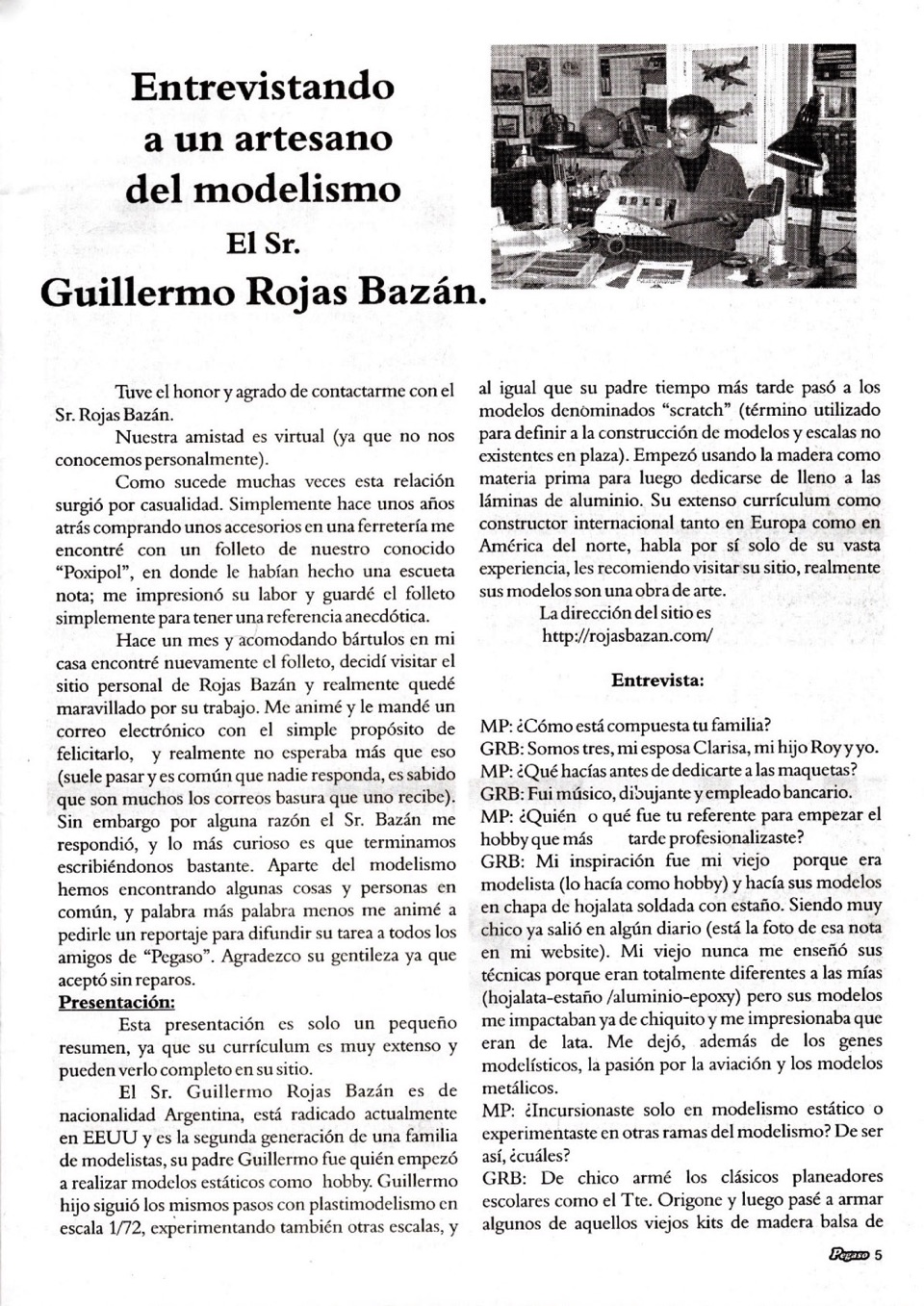
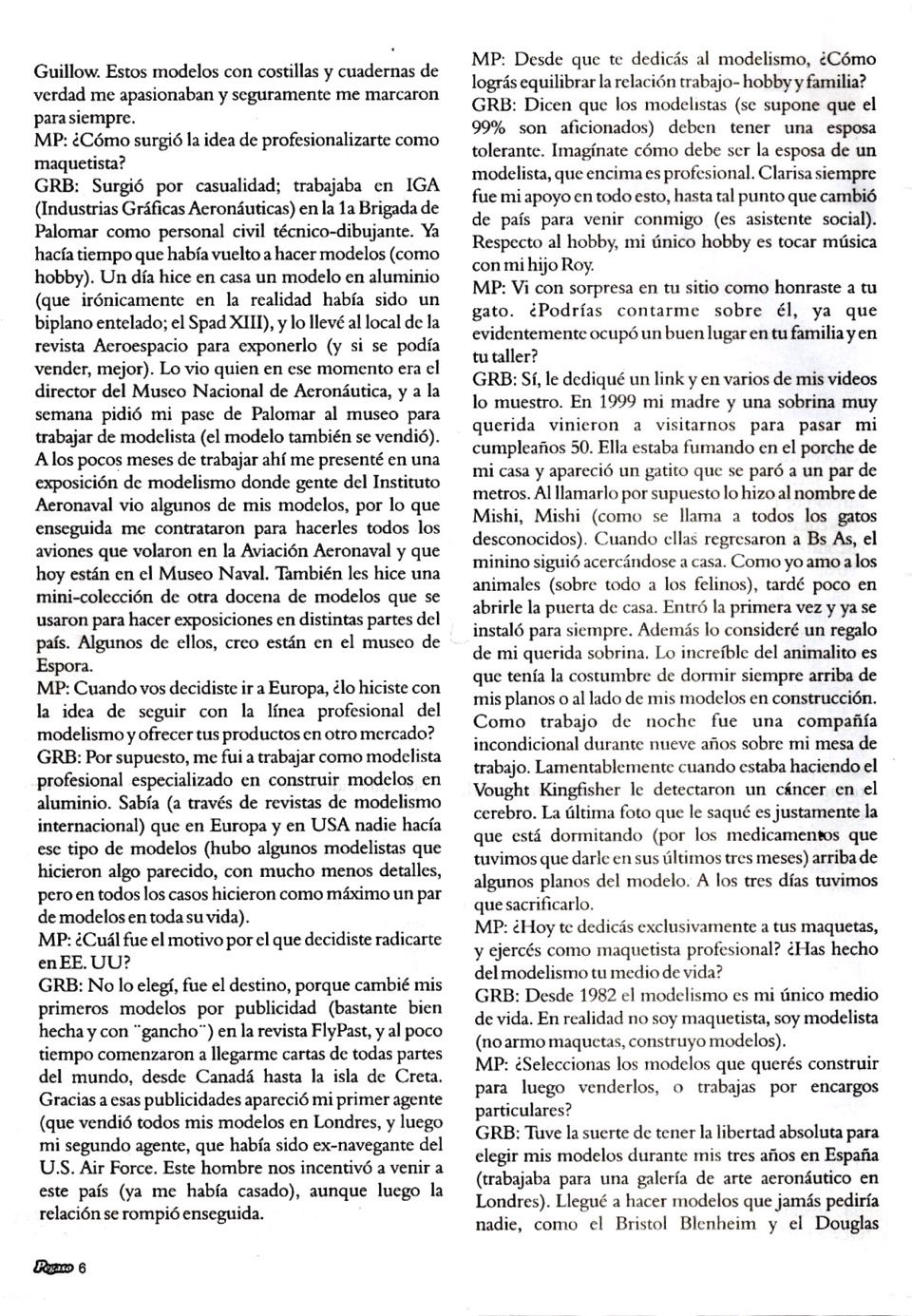
Translation of page 2:
Guillow. These models with ribs and frames really fascinated me and surely marked me forever.
MP: How did the idea of professionalizing yourself as a model maker come about?
GRB: It came about by chance; I worked at IGA (Aeronautical Graphic Industries) in the 1st Palomar Brigade as a civilian technical-draftsman. It had been a while since I had been making models (as a hobby). One day I made an aluminum model at home (which ironically in reality had been a canvas biplane, the Spad). The person who at that time was the director of the National Museum of Aeronautics saw it, and a week later he asked for my pass from Palomar to the museum, to work as a model maker (the model was also sold).
A few months after working there, I appeared at a modeling exhibition where people from the Aeronaval Institute saw some of my models, so they immediately hired me to make all the airplanes that flew in the Aeronaval Aviation and that are today in the Naval Museum. I also made a mini-collection of a dozen models that were used for exhibitions in different parts of the country. Some of them, I believe, are in the Espora museum.
MP: When you decided to go to Europe, did you do it with the idea of continuing with the professional line of modeling and offering your products in another market?
GRB: Of course, I went to work as a professional modeler specializing in building aluminum models. I knew (through international modeling magazines) that in Europe and the USA no one made that type of models (there were some modellers who did something similar, with much less detail, but in all cases they made at most a couple of models in their whole life).
MP: What was the reason you decided to settle in the US?
GRB: I didn't choose it, it was fate, because I exchanged my first models for advertising (quite well done and with "hook") in FlyPast magazine, and soon letters began to arrive from all over the world, from Canada to the Island of Crete. Thanks to those advertisements, my first agent appeared (who sold all my models in London, and then my second agent, who had been a former U.S. Air Force navigator. This man encouraged us (I had already married) to come to this country, although that relationship ended immediately.
MP: Since you dedicated yourself to modeling, how do you manage to balance the relationship between work, hobby and family?
GRB: They say that modelers (99% are supposed to be hobbyists) should have a tolerant wife. Imagine what the wife of a model maker must be like, who is also a professional. Clarisa was always my support in all of this, to such an extent that she changed countries to come with me (she is a social worker). Regarding the hobby, my only hobby is playing music with my son Roy.
MP: I saw with surprise on your site how you honored your cat. Could you tell me about him, as he obviously held a good place in your family and in your workshop?
GRB: Yes, I dedicated a link to him and I show him in several of my videos. In 1999 my mother and a very dear niece came to visit us for my 50th birthday. She was smoking on the porch of my house and a kitten appeared and stopped a couple of meters away. When calling him, she did it by Mishi's name (as all unknown cats are called). When they returned to Buenos Aires, the kitten continued to approach the house. Since I love animals (especially felines), it didn't take me long to open the door to my house. He came in the first time and settled in forever. I also considered it a gift from my dear niece. The incredible thing about the little animal is that he had the habit of always sleeping on top of my plans or next to my models under construction.
As a night job, he was unconditional company for nine years on my work desk. Unfortunately when I was making the Vought Kingfisher he was diagnosed with brain cancer. The last photo I took of him is precisely the one of him dozing (due to the medications we had to give him in his last three months) above some shots of the model. Three days later we had to sacrifice him.
MP: Today you dedicate yourself exclusively to your models? Have you made modeling your livelihood?
GRB: Since 1982, modeling has been my only means of living. Actually I'm not a model maker, I'm a model builder (I don't make models, I build models).
MP: Do you select the models you want to build and then sell them, or do you work on private orders?
GRB: I was lucky to have complete freedom to choose my models during my three years in Spain (I worked for an aeronautical art gallery in London). I got to make models that no one would ever ask for, like the Bristol Blenheim and the Douglas (continues below)
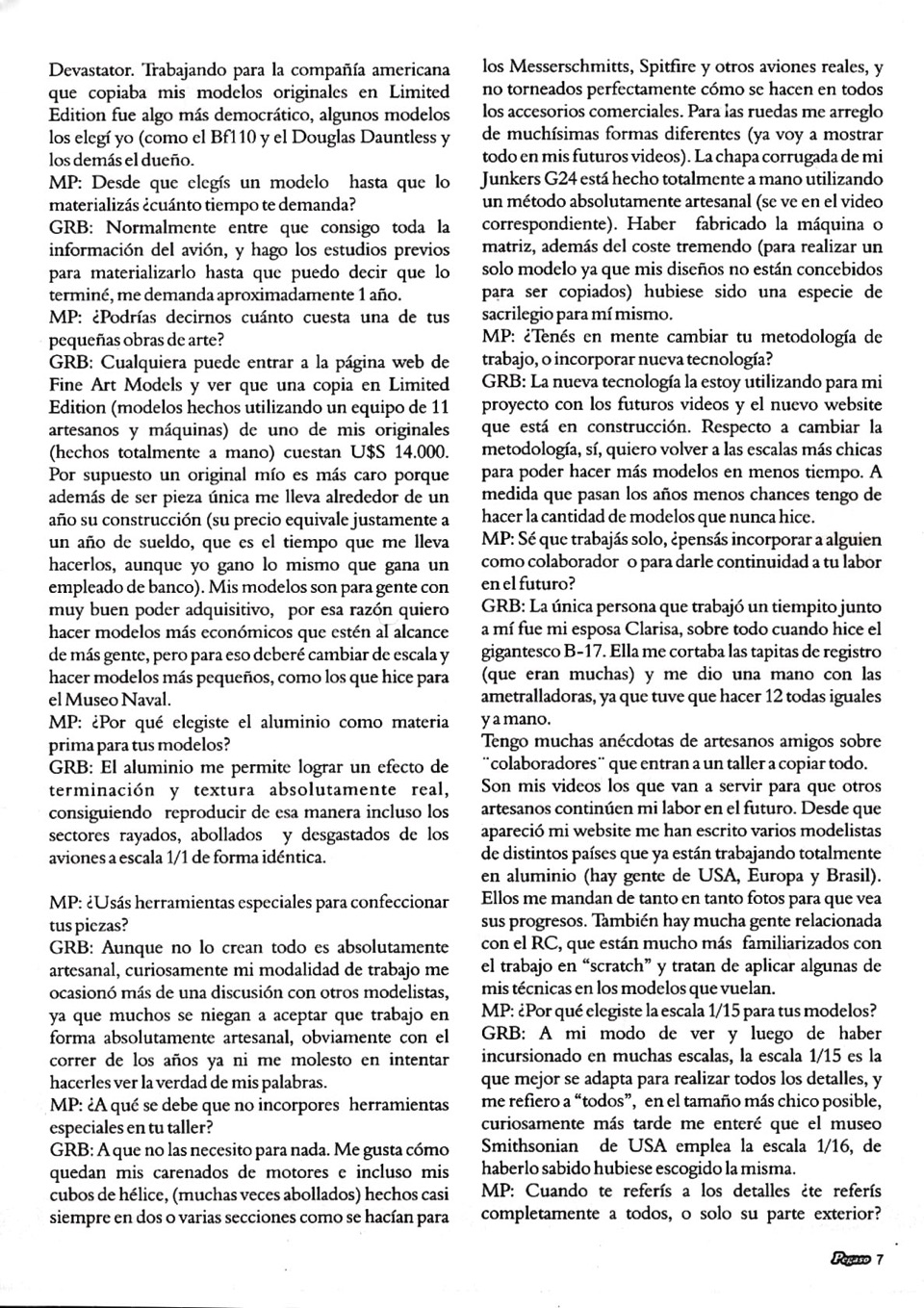
Translation of page 3:
(continues from above) Devastator. Working for the American company that copied my original models in Limited Edition was something more democratic, some models were chosen by me (like the Bf110 and the Douglas Dauntless) and the rest by the owner.
MP: From the moment you choose a model until you materialize it, how much time does it take?
GRB: Normally, between getting all the information about the plane and doing the preparations to materialize it until I can say I finished it, it takes me approximately 1 year.
MP: Could you tell us how much one of your small works of art costs?
GRB: Anyone can go to the Fine Art Models website and see that a Limited Edition copy (models made using a team of 11 craftsmen and machines) of one of my originals (made entirely by hand) costs $14,000.
Of course an original of mine is more expensive because in addition to being a unique piece it takes me about a year to build (its price is exactly equivalent to a year's salary, which is the time it takes me to make them, although I earn the same as a bank clerk). My models are for people with very good purchasing power, for that reason I want to make cheaper models that are affordable to more people, but for that I will have to change the scale and make smaller models, like the ones I made for the Museo Naval.
MP: Why did you choose aluminum as a raw material for your models?
GB: Aluminum allows me to achieve an absolutely real finishing and texture effect, thus being able to reproduce even the scratched, dented and worn sectors of 1/1 scale airplanes identically.
MP: Do you use special tools to make your pieces?
GRB: Although they may not believe it, everything is absolutely artisanal. Curiously my method of work caused me more than one discussion with other modelers, since many refuse to accept that I work in an absolutely artisanal way. Obviously over the years I no longer even care. I don't bother trying to make them see the truth of my words.
MP: Why do you not incorporate special tools in your workshop?
GRB: I don't need them at all. I like how my engine fairings and even my propeller hubs look, (often dented) almost always made in two or several sections as they were made for the Messerschmitts, Spitfire and other real aircraft, and not perfectly rendered as they are done in all commercial props.
For the wheels I style myself in many different ways (I'll show everything in my future videos). The corrugated sheet of my Junkers G24 is made entirely by hand using an absolutely artisanal method (seen in the corresponding video). Having manufactured the machine or matrix, in addition to the tremendous cost (to make a single model since my designs are not designed to be copied) would have been a kind of sacrilege for myself.
MP. Do you have in mind changing your work methodology, or incorporating new technology?
GRB: I am using the new technology for my project with future videos and the new website that is under construction. Regarding changing the methodology, yes, I want to go back to smaller scales so I can make more models in less time. As the years go by, I have less chance of making the number of models I never made.
MP: I know that you work alone, do you plan to incorporate someone as a collaborator or to give continuity to your work in the future?
GRB: The only person who worked with me for a while was my wife Clarisa, especially when I made the gigantic B-17. She cut the manhole covers for me (which were many) and gave me a hand with the machine guns, since I had to make 12 of them all the same and by hand.
I have many anecdotes from artisan friends about "collaborators" who enter a workshop to copy everything. It is my videos that will help other artisans continue my work in the future. Since my website appeared, several modelers from different countries have written to me who are already working entirely in aluminum (there are people from the USA, Europe and Brazil).
They send me photos from time to time so I can see their progress. There are also many people involved in RC, who are much more familiar with scratch work and try to apply some of my techniques to the models they fly.
MP: Why did you choose the 1/15 scale for your models?
GRB: In my opinion and after having ventured into many scales, the 1/15 scale is the one that best adapts to making all the details, and I mean "all", in the smallest size possible. Curiously, I later found out that the Smithsonian Museum in the USA uses 1/16 scale, if I had known I would have chosen the same one.
MP: When you refer to the details, are you referring to all of them completely, or just their exterior part? (continues below)
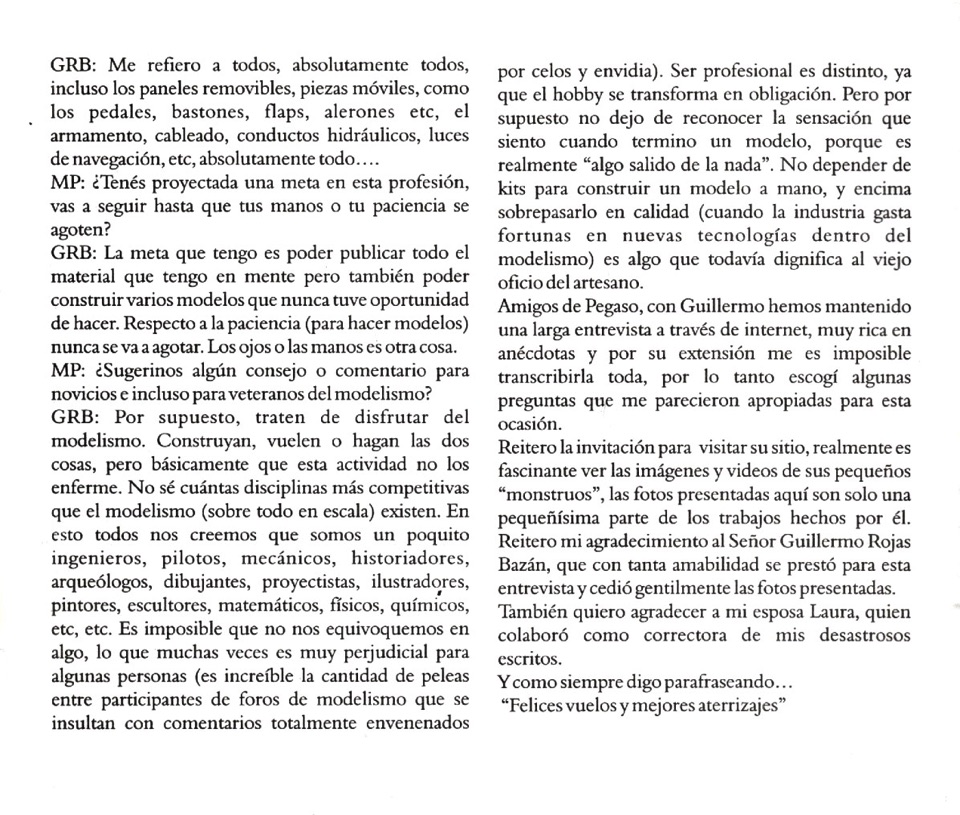
Translation of page 4:
GRB: I mean everything, absolutely everything, including the removable panels, moving parts, such as pedals, sticks, flaps, ailerons, etc., the armament, wiring, hydraulic conduits, navigation lights, etc., absolutely everything...
MP: Do you have a goal planned in this profession, are you going to continue until your hands or your patience run out?
GRB: The goal I have is to be able to publish all the material that I have in mind but also to be able to build several models that I never had the opportunity to do. Regarding patience (for making models) it will never run out. The eyes or the hands is something else.
MP: Can you suggest any advice or comments for novices and even veterans of modeling?
GRB: Of course, try to enjoy modeling. Build, fly or do both, but basically don't let this activity make you sick. I don't know how many more competitive disciplines than modeling (especially in scale) there are. In this, we all believe that we are a little bit of engineers, pilots, mechanics, historians, archaeologists, draftsmen, designers, illustrators, painters, sculptors, mathematicians, physicists, chemists, etc., etc. It is impossible for us not to be wrong about something, which is often very harmful to some people (it is incredible the number of fights between participants in modeling forums who insult each other with totally poisoned comments out of jealousy and envy).
Being a professional is different, since the hobby becomes an obligation. But of course I can't stop recognizing the feeling I feel when I finish a model, because it is really "something out of nowhere." Not depending on kits to build a model by hand, and on top of that surpassing it in quality (when the industry spends fortunes on new technologies within modelling) is something that still dignifies the old craft of the craftsman.
Friends of Pegaso, Guillermo and I have had a long interview over the internet, very rich in anecdotes and due to its length it is impossible for me to transcribe it all, therefore I chose some questions that seemed appropriate for this occasion.
Translation of pages 5, 6, 7 and 8: these pages only have images and the short captions are self explanatory. The pages are shown below for completeness. Or you can return to the Press page.
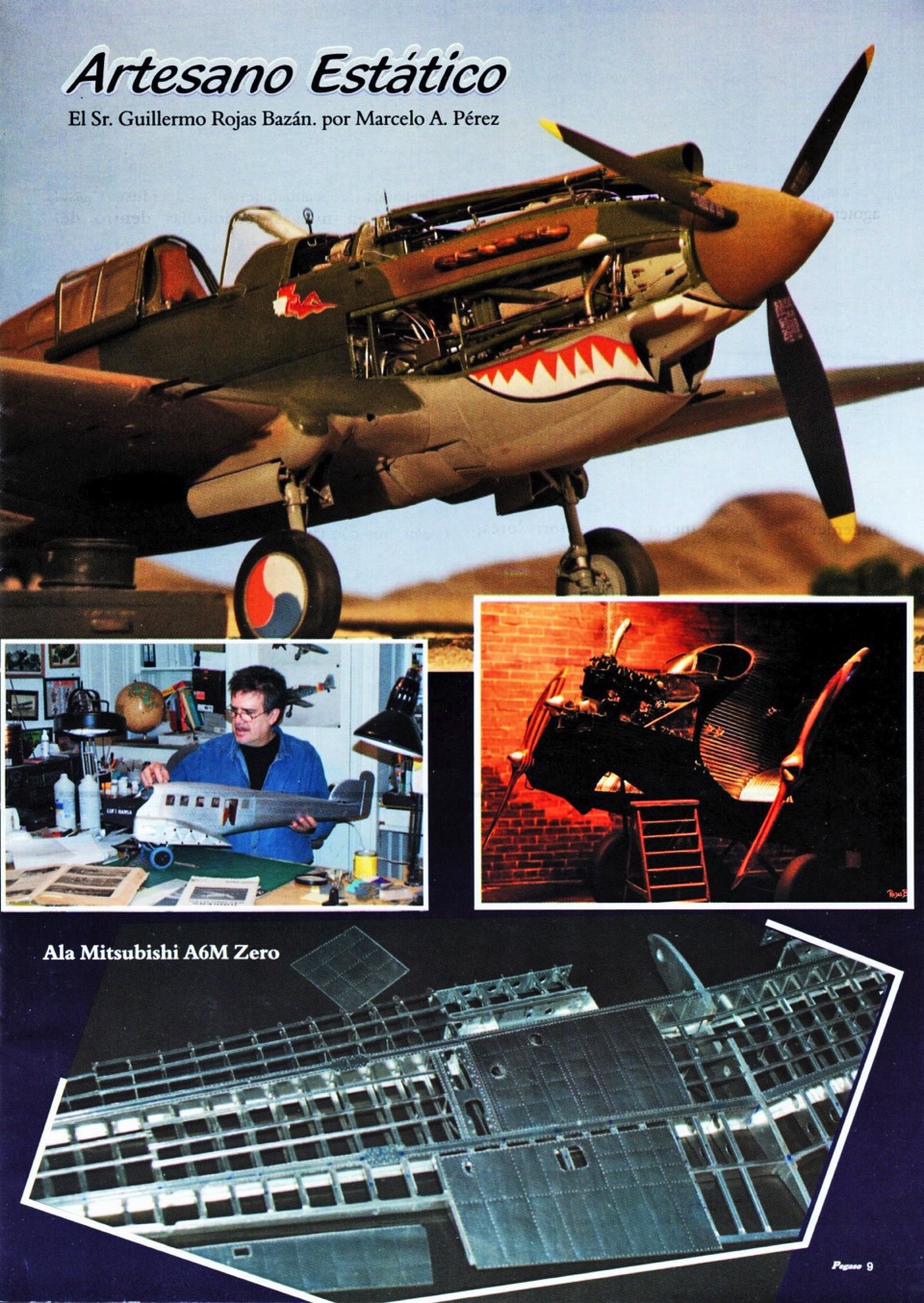
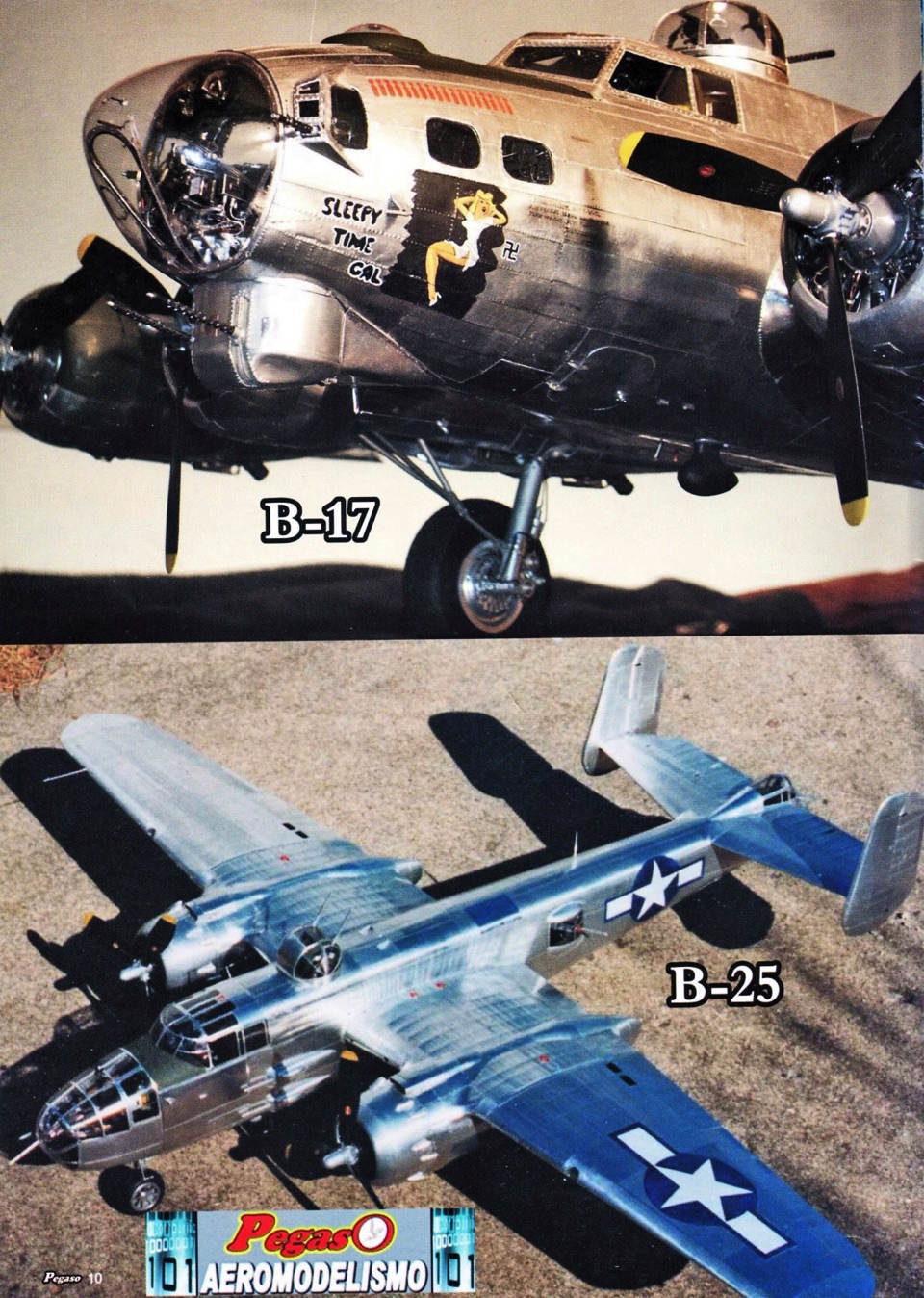
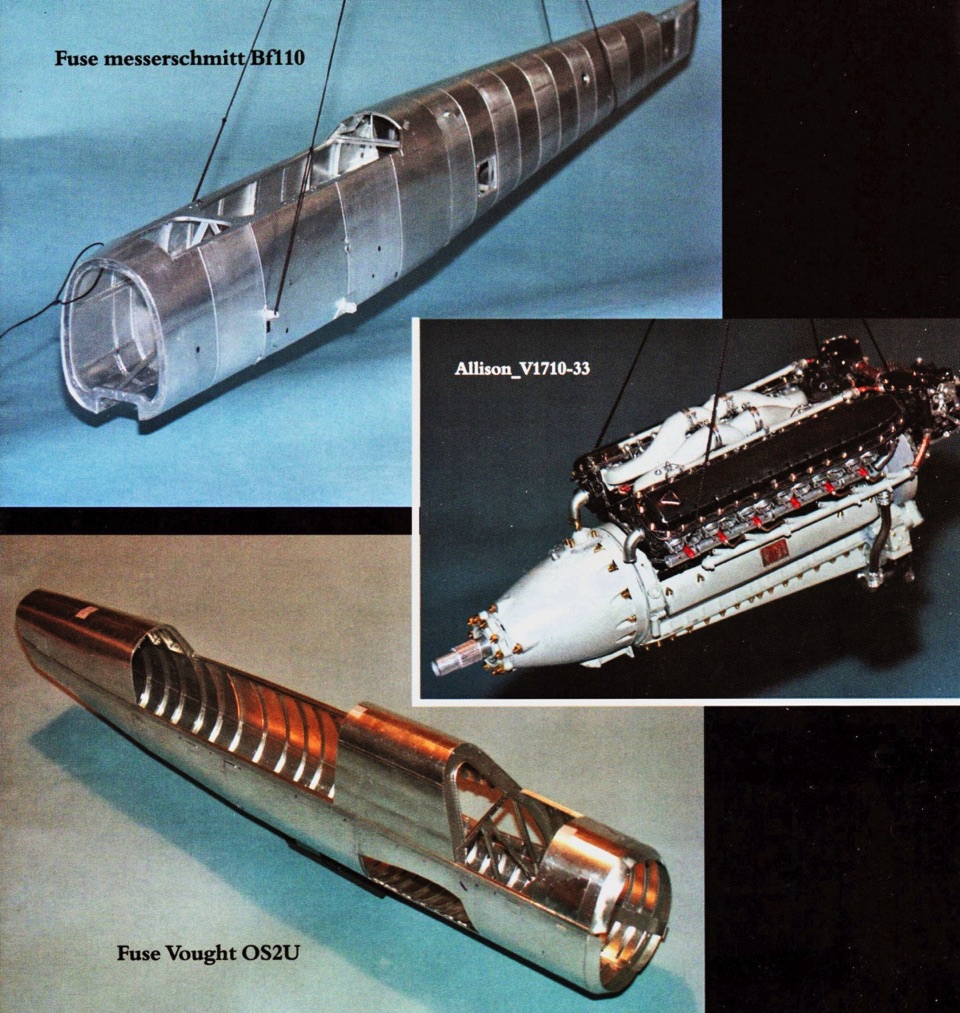
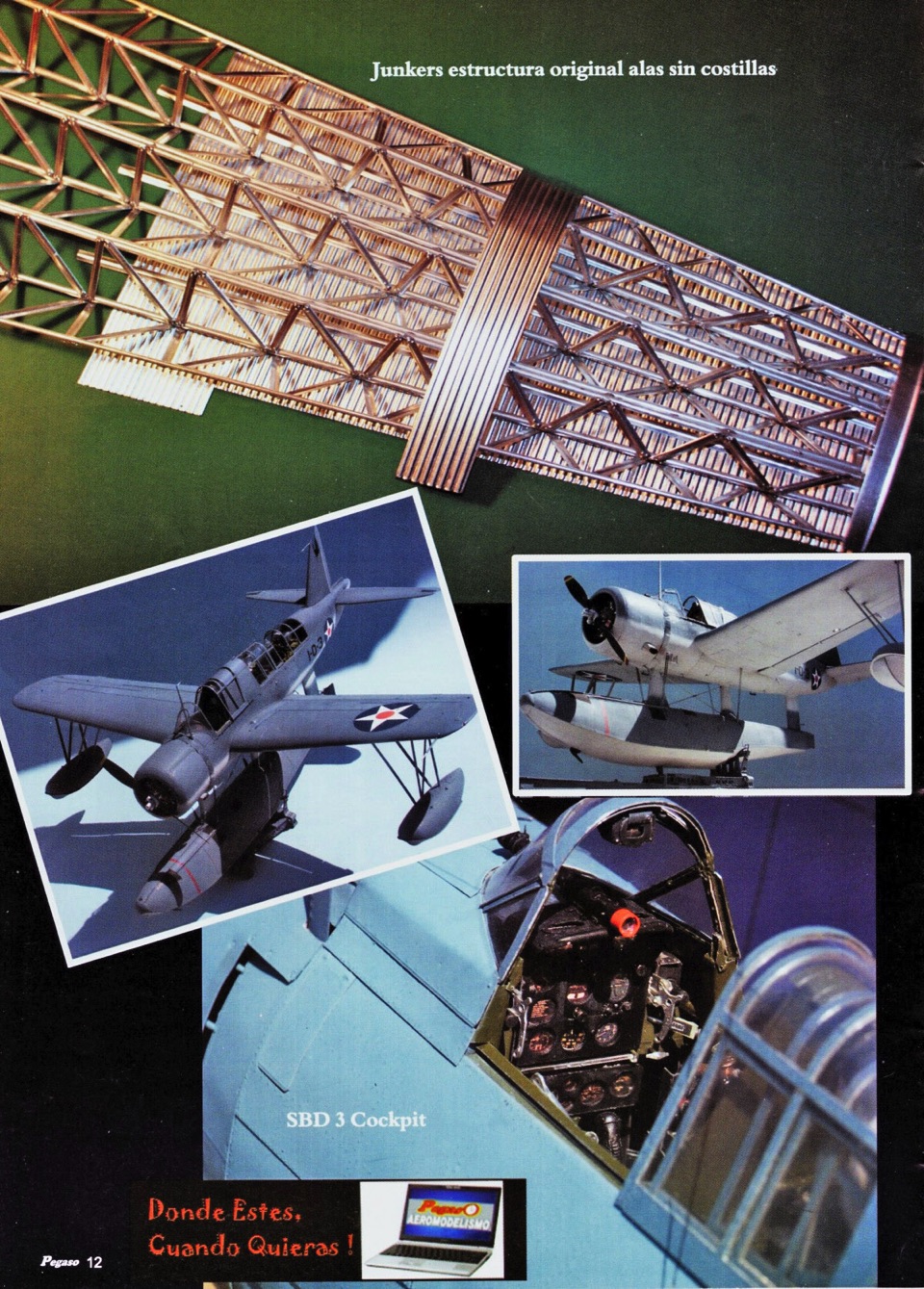
Below: Junkers original structure wings without ribs
